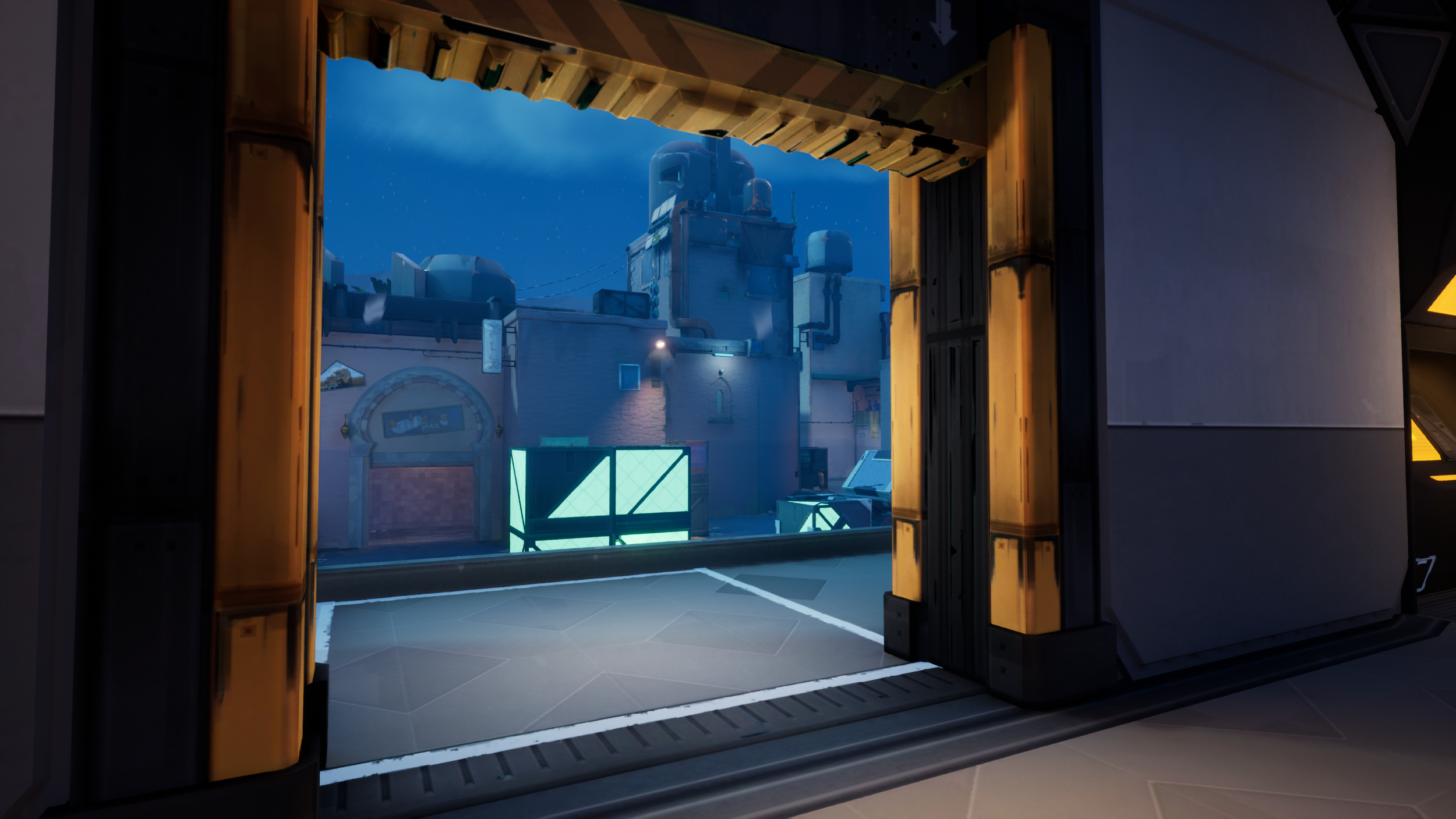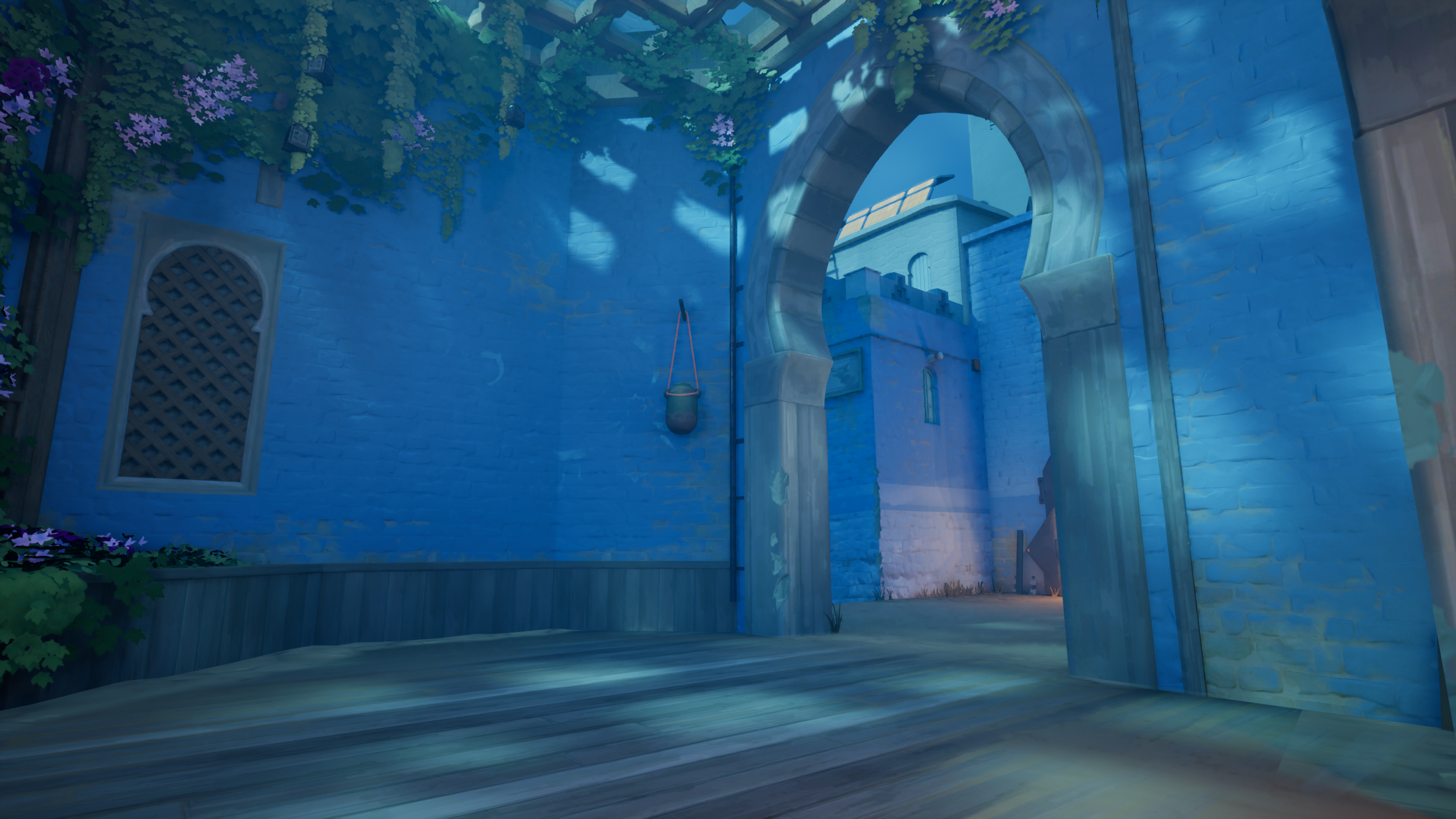Please view on desktopIn Morocco's capital of Rabat, Kingdom Corporation seeks to expand further into the city. Having already set up a Radianite refinery there, the organization looks to do more, dismantling any cultural property in the way of their latest projects. However, fully aware at this point of the lies behind the promises with the corporation's initial arrival, locals hold strong opposition to any more Kingdom activity in their home.
WHAT WOULD BIND LOOK LIKE AT NIGHT?
GETTING STARTED
For most stylized games, night-time is often portrayed with intense blue. Since there wasn’t any night material that I could reference to in Valorant, I decided on embracing the game’s vibrant colours and cross referencing photos of actual deserts.
Since Bind by default is very orange (like any other desert in the Middle East), I figured the difference between night and day would be more interesting with a contrasting colour such as blue, as opposed to balancing the colour temperature. It also plays well into the map’s codename being ‘Duality’!
DIRECTION
Now that an overall colour has been established, the first thing to do was to find the right angle for our key light. For this scene, I wanted the environment to be washed over with moonlight. Finding the right angle was a lot of trial and error, as I was proceeding with the following criteria:
Ensure that the main playing areas (site, lanes) had a good mix of shadows and light
Shadows create interesting shapes on the environment to further add depth
Ensure that neither attackers or defenders have an advantage because one side is darker than the other *
With this in mind, I used Lumen to get real-time results to speed up this process before switching to baked lighting.
With just the key light alone, the shadows were way too dark. I fixed this to match Valorant’s softer, lighter shadows by increasing the indirect lighting intensity of the key light, creating a skylight with a similarly high indirect lighting intensity and enabling real-time capture to tie everything together.
*In reality it is impossible to light everything with 1 keylight, so I strategically placed the shadows in areas with other motivated lighting
MOTIVATED LIGHTING
This is the fun part where we get to apply our research and worldbuilding to our relight.
The first thing to consider is looking at what already exists within the map. Bind is divided into two parts: The attacker’s side consists of traditional Moroccan architecture with residential spaces, markets and art scattered around the walls. This side also adorns several solar panels. The defender’s side has been taken over by Kingdom Corporation. Here we can see large smoke stacks and cold, metallic industrial architecture bleeding into the city.
The first lighting observation we can make is that Kingdom’s lab and refinery are all very well lit with arrays of sterile feeling lights. The exception is the refinery (A site tower), which is lit with orange lights. The residential side, on the other hand, has lamps that are spaced out and directly connected to the solar panels.
With that being said, going from day to night and changing the angle of the key light presented some problems as mentioned in the third point above. Notably, since the attacker side only had a few lamps scattered around the area, some parts of the map (such as fountains and B long) were too dark. Fortunately, this was a simple fix. Power lines along the walls connected to the solar panels made it easy to add in lamps in areas that were needed.
IMPORTANCE OF CONTRAST
Deserts are typically cold at night too, so a blue tone really sells both the feeling of coldness and night
To add in a sense of life back into the Moroccan markets, I decided to light the interior of the market stands, letting light shine through the products and bleed onto the ground. Referencing night-life in Rabat, we can see that the city favours using warm lights.
I settled on keeping each market light to a temperature of 2500k for consistency and to give off an inviting warm light. The surrounding lamps I kept at 3500k to provide some separation for easy readability.
Colourful, vibrant walls.
Cracked, worn down bricks.
Improvised roofing.
Organized chaos.
To make long range engagements easier to see, the Valorant dev team will often use a combination of both colour and luminance contrast on the walls at long sightlines. This combination provides a bright backdrop, making characters easier to identify in terms of silhouette readability and visual clarity.
Highlighted with the red and green circle, we can observe this practice being applied. The window circled in red is a more obvious example of this, with the bright red interior directly contrasting with the blue exterior walls. Although my night version of Bind makes pretty much everything a shade of blue, I've used a combination of warm lights and fake lighting to exaggerate brightness to replicate this practice.
Multiple light sources were used to brighten up spaces and fake bounce lighting from major sources of light, such as the moonlight in this picture. Given the nature of the game, all lighting sources are static and baked.
Lighting detail only
Overhead view of the entire map
A site - Using the surrounding buildings and props to create long interesting shadows while keeping most of the site lit
Straight, precise lines. Grey/monotones.
No corner left unlit.
Uniform design.
Added lamps to brighten up darker, hard-to-see areas.
RESULTS
Finally, putting everything together, here is Bind at night on Epic settings in Unreal Engine 5
PERFORMANCE & OPTIMIZATION
As seen in the screenshots below, performance ranged from 70-120 FPS, averaging at around the mid 90 FPS at any given part of the environment. Keep in mind that I am running at maximum settings at 1080p on an RTX 3070.
There is definitely room for improvement in terms of performance. The first being that my setup uses a sky atmosphere with volumetric clouds. Valorant uses a texture for its sky instead to save on performance.
The second method I can use is checking for overlapping lights and ensuring that the attenuation radii are not overlapping with each other. This method will be time consuming as there are a lot of lights in this environment, so I will be taking this bit of knowledge into my next projects.
Another way to save on performance would be to disable ‘cast shadows’ on point lights that were used as fake bounce lighting, as it would make a very minimal visual difference.
The final method that I can think of is to adjust unoptimized lightmap densities, which would result in better performance, but worse lighting quality.
Overall, this project was a great learning experience - And there’s so much more to learn! It’s honestly so cool seeing how different a familiar environment can feel and look just by changing its lighting.
If you made it this far, I want to personally give my thanks to you. It means a lot that you took time out of your day to read this. I hope that you learned something new, or maybe have a newfound appreciation for game lighting :)
Let me know your thoughts!
What do you think? Do you think that I succeeded in capturing the essence of night? Would you play on this version of Bind? Is there anything else I could improve on? Anything you would change? Let’s chat! Be sure to preface your message with “Bind, Night”.






















































